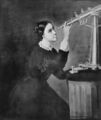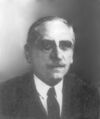Template:Selected anniversaries/June 28: Difference between revisions
No edit summary |
No edit summary |
||
| Line 6: | Line 6: | ||
||1717: Matthew Stewart born ... mathematician and minister of religion. Pic. | ||1717: Matthew Stewart born ... mathematician and minister of religion. Pic. | ||
||1740: Physician and soldier Moses Nichols born ... American Revolution. Pic search gravestone | ||1740: Physician and soldier Moses Nichols born ... American Revolution. Pic search gravestone. | ||
||1754: Martin Folkes dies ... antiquary, numismatist, mathematician, and astronomer. Pic. | ||1754: Martin Folkes dies ... antiquary, numismatist, mathematician, and astronomer. Pic. | ||
| Line 18: | Line 18: | ||
||1852: Wilhelm Hisinger dies ... physicist and chemist who in 1807, working in coordination with Jöns Jakob Berzelius, noted that in electrolysis any given substance always went to the same pole, and that substances attracted to the same pole had other properties in common. This showed that there was at least a qualitative correlation between the chemical and electrical natures of bodies. Pic. | ||1852: Wilhelm Hisinger dies ... physicist and chemist who in 1807, working in coordination with Jöns Jakob Berzelius, noted that in electrolysis any given substance always went to the same pole, and that substances attracted to the same pole had other properties in common. This showed that there was at least a qualitative correlation between the chemical and electrical natures of bodies. Pic. | ||
||1873: Alexis Carrel born ... surgeon and biologist, Nobel Prize laureate. | File:Maria Mitchell.jpg|link=Maria Mitchell (nonfiction)|1870: Astronomer and crime-fighter [[Maria Mitchell (nonfiction)|Maria Mitchell]] publishes new class of [[Gnomon algorithm functions]] which predict and prevent [[crimes against astronomical constants]]. | ||
||1873: Alexis Carrel born ... surgeon and biologist, Nobel Prize laureate ... Perfusion pump w/ Charles Lindbergh. Pic. | |||
File:Henri Victor Regnault 1860s.jpg|link=Henri Victor Regnault (nonfiction)|1874: Chemist, physicist, and crime-fighter [[Henri Victor Regnault (nonfiction)|Henri Victor Regnault]] says that advances in physical chemistry "will soon be used for physically-based [[crimes against mathematical constants]], for example the conversion of matter to antimatter, with catastrophic consequences." | File:Henri Victor Regnault 1860s.jpg|link=Henri Victor Regnault (nonfiction)|1874: Chemist, physicist, and crime-fighter [[Henri Victor Regnault (nonfiction)|Henri Victor Regnault]] says that advances in physical chemistry "will soon be used for physically-based [[crimes against mathematical constants]], for example the conversion of matter to antimatter, with catastrophic consequences." | ||
| Line 24: | Line 26: | ||
File:Henri Lebesgue.jpg|link=Henri Lebesgue (nonfiction)|1875: Mathematician and academic [[Henri Lebesgue (nonfiction)|Henri Lebesgue]] born. He will gain fame for his his theory of integration, which generalizes the 17th century concept of integration (summing the area between an axis and the curve of a function defined for that axis). | File:Henri Lebesgue.jpg|link=Henri Lebesgue (nonfiction)|1875: Mathematician and academic [[Henri Lebesgue (nonfiction)|Henri Lebesgue]] born. He will gain fame for his his theory of integration, which generalizes the 17th century concept of integration (summing the area between an axis and the curve of a function defined for that axis). | ||
||1879: Wilhelm Steinkopf born ... chemist ... worked on the production of mustard gas during World War I. Pic search | ||1879: Wilhelm Steinkopf born ... chemist ... worked on the production of mustard gas during World War I. Pic search. | ||
File:Georgy Voronoy.jpg|link=Georgy Voronoy (nonfiction)|1888: Mathematician [[Georgy Voronoy (nonfiction)|Georgy Voronoy]] publishes new class of [[Gnomon algorithm]] tessellations which detect and expose [[math labs]]. | File:Georgy Voronoy.jpg|link=Georgy Voronoy (nonfiction)|1888: Mathematician [[Georgy Voronoy (nonfiction)|Georgy Voronoy]] publishes new class of [[Gnomon algorithm]] tessellations which detect and expose [[math labs]]. | ||
Revision as of 13:07, 23 September 2020
1598: Cartographer and geographer Abraham Ortelius dies. Ortelius created the first modern atlas, the Theatrum Orbis Terrarum. He was also one of the first to imagine that the continents were joined together before drifting to their present positions.
1712: Philosopher and author Jean-Jacques Rousseau born. His political philosophy will influence the Enlightenment in France and across Europe.
1824: Physician, anatomist, and anthropologist Paul Broca born. He will discover that the brains of patients suffering from aphasia contain lesions in a particular part of the cortex, in the left frontal region -- the first anatomical proof of the localization of brain function.
1825: Chemist and academic Emil Erlenmeyer born. He will contribute to the early development of the theory of structure, formulating the Erlenmeyer rule, and designing the Erlenmeyer flask.
1870: Astronomer and crime-fighter Maria Mitchell publishes new class of Gnomon algorithm functions which predict and prevent crimes against astronomical constants.
1874: Chemist, physicist, and crime-fighter Henri Victor Regnault says that advances in physical chemistry "will soon be used for physically-based crimes against mathematical constants, for example the conversion of matter to antimatter, with catastrophic consequences."
1875: Mathematician and academic Henri Lebesgue born. He will gain fame for his his theory of integration, which generalizes the 17th century concept of integration (summing the area between an axis and the curve of a function defined for that axis).
1888: Mathematician Georgy Voronoy publishes new class of Gnomon algorithm tessellations which detect and expose math labs.
1889: Astronomer and academic Maria Mitchell dies. She was the first American woman to work as a professional astronomer.
1906: Physicist and academic Maria Goeppert-Mayer born. She will develop a mathematical model for the structure of nuclear shells, for which she will be awarded the Nobel Prize in Physics in 1963, which she will share with J. Hans D. Jensen and Eugene Wigner.
1973: Chemist and acclaimed screenwriter Marc Julia wins the Academy Awards Best Screenplay Award for The Julia Olefination, "a tense and exciting thriller, combining phenyl sulfones with aldehydes (or ketones) to give alkenes after alcohol functionalization and reductive elimination using sodium amalgam or SmI2."









